Seeing stars at Dom Pérignon
December 23, 2013
By Panos Kakaviatos
As we celebrate the holidays and approach the end of 2013, wine lovers get giddy and bubbly.
Champagne may be great to drink anytime, but demand increases substantially in this winter season, and for that reason, it is good to know that one need not spend too much on a fine bottle. During a Paris salon earlier this month – Le Grand Tasting – I sampled lovely bottles of moderately priced non-vintage Champagnes, including the thoroughly underrated Drappier, a new release from Piper Heidsieck called “Essentiel”, which has a lower dosage and tastes more refreshing and focused, Larmandier-Bernier and Deutz Brut – another rather underrated non-vintage bubbly. These and others provide well balanced aromas and vibrant flavors including citrus and brioche with full bodied character, complemented with fine bubbles and freshness.
For special occasions, prestige vintage Champagne is the ticket.
Many options exist. At the salon for example, I fell in love with pure and pristine Philipponnat Clos des Goisses 2004. Some days later over dinner at a wine connoisseur’s home, I was very impressed with the Jacques Selosse 2002 vintage, which combined profound richness with precision. I recently opened a delectable Pol Roger Cuvee Winston Churchill 1999.
Champagne beguiles wine lovers for various reasons. Certainly its luxurious image is one. For centuries, royal families throughout Europe spread the message of the unique sparkling wine from Champagne and its association with luxury and power. Leading manufacturers devote considerable energy to create a history and identity for their wines, associating it and themselves with high luxury, festivities, and fun.
Contrary to legend and popular belief, Dom Pérignon did not invent sparkling wine, but he did make important contributions to the production and quality of Champagne wine, including careful blending of different vats to maintain high quality from one vintage to the next and creating a gentle press for the grapes. Although the oldest recorded sparkling wine is Blanquette de Limoux – near Carcassonne in 1531 – over a century later, English scientist and physician Christopher Merret documented the addition of sugar to a finished wine to create a second fermentation, which occurred six years before Dom Pérignon set foot in the Abbey of Hautvillers and almost 40 years before it was claimed that the famed Benedictine monk invented Champagne.
Whatever the case may be, the Champagne bearing the name of the famous Benedictine monk and cellar master at the Abbey in Hautvillers, just outside Epernay, is well known for its vivacity and sumptuousness and deservedly counted among the very best Champagnes in the world.
The view from the abbey – almost 400 meters overlooking Champagne vineyards – was breath-taking as Dom Pérignon oenologist Vincent Chaperon served six different vintages in what was once the abbey’s “scriptorium”, where some 5,000 works were printed.
Chaperon, 38, comes from Pomerol. His family once owned Château Nenin, the second largest estate from the prestigious Bordeaux appellation. After studying agricultural engineering in Montpellier, he moved to Champagne and, since 2005, he has been chief oenologist for Dom Pérignon wine director Richard Geoffroy.
Chaperon enthusiastically yet carefully explained the philosophy and style of Dom Pérignon as “defying oxidation”. The first release of a vintage, with its well-known olive label, comes after the wine has remained in contact with the lees in bottle for seven years. The second release – with the more prestigious black label Oenotheque – is issued following in-bottle aging for at least 11 years. And the third release, the black label with gold lettering Oenotheque, is released after 30 or more years. Although generally a 50-50 blend of Pinot Noir and Chardonnay, percentages vary according to vintage.
All Oenothque bottles are storied upside down before they are disgorged. “We now understand that after seven years, the protective role of the dead yeasts is lower, so in storing the bottles upside down, deposits fall to the neck and create an added protective layer against oxygen,” Chaperon explained.
Dom Pérignon’s famous creamy texture with distinct notes of brioche comes from this long contact with the dead yeasts which – as Chaperon explained – lead to a more integrated wine. “It is not unlike what Burgundians do when they stir the lees in barrel, but in Champagne, the interaction is for a much longer term and more ‘intimate’ as it occurs in the bottle.” One could think that the wine is aged in some with oak, given the toasty brioche flavor, but Dom Pérignon sees no oak whatsoever in its aging: the contact with the dead yeasts in bottle bring out that pleasing flavor.
2003 and 2004: two distinct styles
We began our tasting with a comparison between the most recently issued 2004 and 2003 vintages. While the 2004 seems superior overall, the 2003 has more character. Some compare the 2004 to the 2002, but not as precise or intense. Perhaps another comparison could be made with the 2000, as both convey opulence, balanced by tension.
The 2003 was better than I had expected. Served next to the 2004, it was noticeably darker. But not oxidized, Chaperon stressed. Before the first fermentation, the juice as it came off the press had been oxidized for a few hours, so as to make it more resistant to oxidation once it was fermented, Chaperon explained. Hence the darker color. He explained that taking such an exceptional measure before fermentation strengthened the wine against oxidation.
Indeed, the 2003 gave off much more freshness than I thought, as many commentators have scratched their heads, asking why Dom Pérignon would bother to make Champagne from the torrid 2003 vintage. But the wine’s rich, yellow fruit aspect contributed to a pleasing mid palate, with subtle power due to the phenolic ripeness achieved. Atypically, it has a higher proportion of Pinot Noir (62%), given the greater success of that grape in that vintage.
The 2004 has perhaps slightly more Chardonnay than 50-50. I lean towards favoring the greater freshness and zing in the 2004, but the 2003 may turn out to be special with time in bottle.
A pair of rosés – 2003 and 2002
The 2003 rosé is superb: the Pinot did very well in that vintage. Its flavors are distinct and memorable – rich in crystalline red fruit expressions, with a broad and seductive mid palate and enveloping full body that is never heavy handed, yet pleasingly pronounced, leading to a long finish marked by the Pinot Noir ripeness. The 2002 proved tightly coiled, as if it were a cord for a trapeze artist, but with a more impressive finish, more linear, and I suspect time in bottle will reveal the 2002’s greatness. I would not bother opening one today, however. For now, the 2003 is more fun, tastier and deeper.
Rosés are released one year after the regular wines, to give the 20% or so added Pinot Noir wine the “right time to integrate”, Chaperon explained. In rare vintages, Dom Pérignon releases only rosé (1986) or no rosé and just regular (1999).
A pair of Oenotheques: 96 to 69
Before tasting the rosés, we tasted the Oenotheque 1996, which offers everything anyone would want from great Champagne: vibrancy, tension, a panorama of aromas and flavors and a more intense brioche like creamy texture coming from the long contact with the lees in bottle. The bottle had been disgorged in 2008. It exuded fresh notes of grapefruit and lemon but with mocha, and superb precision and focus, with fine and vibrant bubbles balancing the creamy texture.
You could almost drink it now, but it needs time in glass to soften its coiled up sensation, and would be better to save for a few years ideally.
What stole the show was the 1969 Oenotheque, disgorged in 2006. After some 30 years in bottle, this wine displayed no oxidized notes. It released a pure truffle aroma when first opened, but then revealed vibrant citron notes – perhaps surprising for older Champagne. The mid palate, smooth and creamy, was marked yet again by brioche and other patisserie-like flavors before ending with espresso, chocolate and nougat on a very long finish that teases the taster. Almost as an afterthought, one notices the refined light yet persistent bubbles complementing the vinosity of the 1969, which was a warm vintage, Chaperon explained.
Chaperon explained that Dom Pérignon wines follow the rhythm of three “plenitudes” – the first after seven years maturing on their lees; the second between eleven and twenty years; and the third beyond twenty.
Before the tasting, Dom Pérignon brand ambassador Andrea Marx gave a tour of the abbey and its adjoining church, where Dom Pérignon the monk was buried. Founded in the 7th century, the abbey has been restored many times throughout its existence. Both Dom Pérignon and King Louis XIV, a fan of the wines already being made at the abbey, were born in 1638 and died in 1715. The most recent restoration at the abbey was finished just one year ago, to refurbish a massive portal to a next-door pavilion where the daughters of the French king came to visit. The restoration, which took three months, contributes to a dossier before UNESCO to name the abbey a world heritage site.

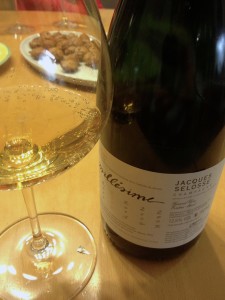

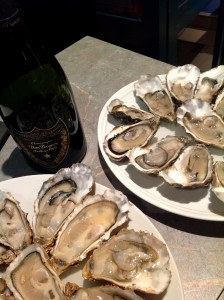
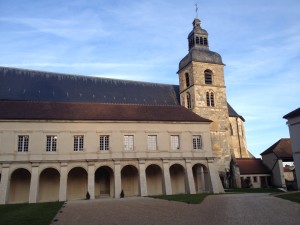
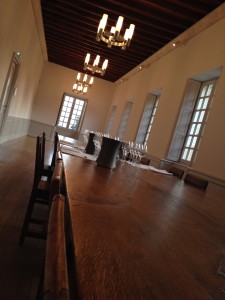

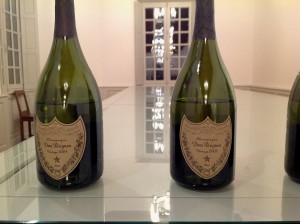

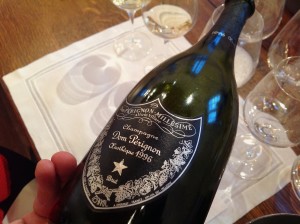
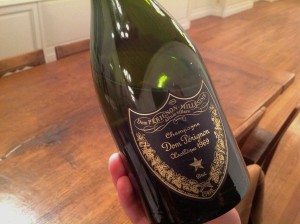
[…] Kakaviatos tastes through several different vintages of Dom […]